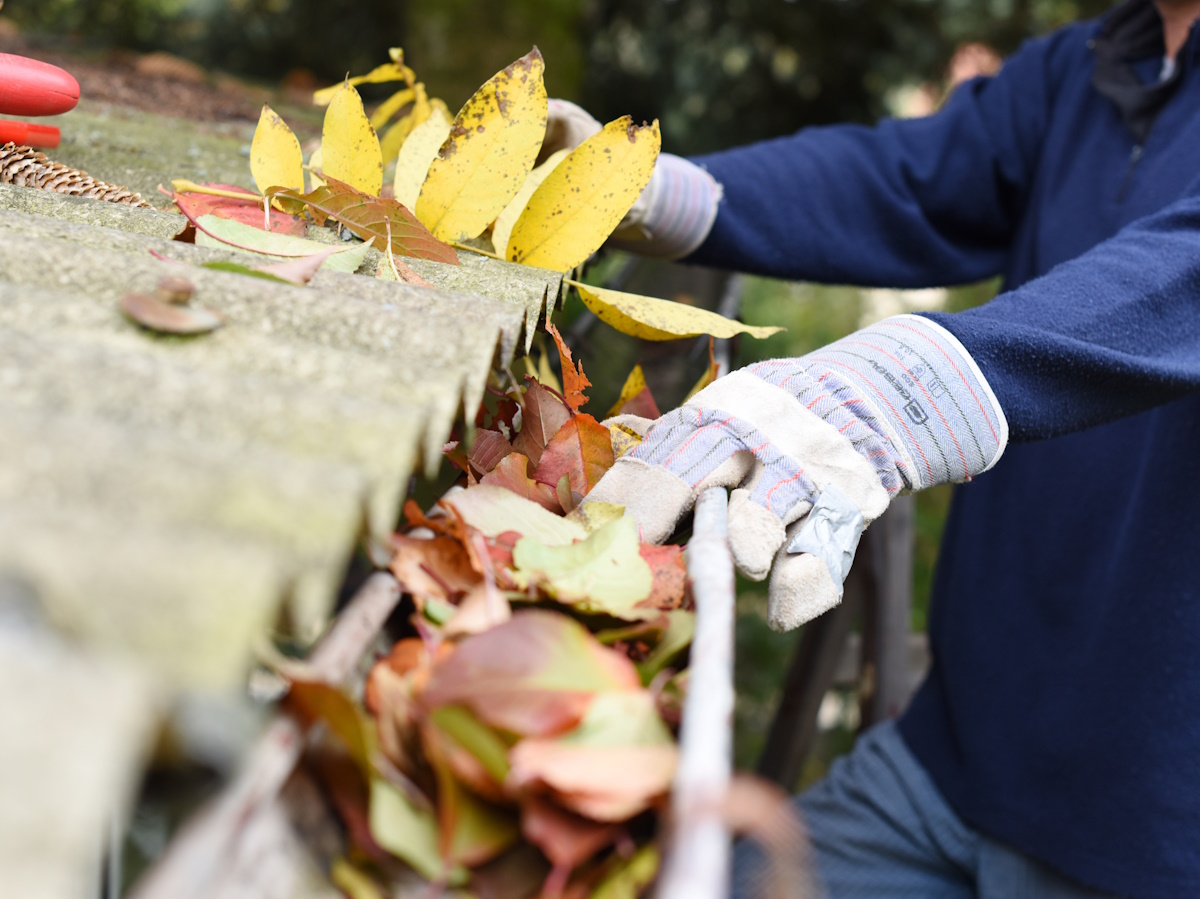Prevent Roof and Interior Damage and Gutter Debris Build-Up by Following These Guidelines
Gutters collect more than rainwater, and when that happens, a cleaning is necessary. Cleaning your gutters twice a year – or more often if your house is surrounded by trees – keeps them in good condition and prevents costly repairs to your roof and your home’s interior. Neglecting your gutters can lead to a host of problems, including water damage to your home’s ceilings, mold growth, and even foundation issues if not addressed in time.
It’s no surprise that gutter cleaning can be a dirty job, so you’ll need preparation, the right equipment, and some know-how to get it done. Thankfully, it tends to be a fairly simple job.
Before you step on the ladder this season, follow these instructions on clearing debris from your gutters and downspouts, while keeping safety in mind.
Why Do Gutters Get Clogged?
Gutters and their attached downspouts direct rainwater away from your home’s foundation, preventing water damage and soil erosion. However, they can quickly become clogged with leaves, twigs, asphalt shingle granules, acorns, maple leaf “helicopter” seeds, and other debris. This debris lands in your gutters due to wind or when rain washes it from your roof into your gutters. As these materials build up, they impede water flow and can cause your gutters to overflow.
Even if you have gutter guards installed, this debris can still collect over time. However, you may be able to reduce the frequency of cleanings when they’re installed.
Tools and Materials You’ll Need for Gutter Cleaning
Before you begin cleaning your gutters, gather the necessary tools and materials:
- Safety gear: You’ll need work gloves, safety goggles, and non-slip footwear to protect yourself from debris and nasty accidents.
- Ladder: Use a sturdy ladder that reaches the height of your gutters. Ensure it’s placed on stable, dry ground. Have someone hold it for added stability.
- Gutter scoop or trowel: For open gutters, a scoop or trowel will help you remove large debris such as leaves and twigs from your gutters. Some people prefer to use their hands instead; you may want to wear work gloves if this applies to you.
- Bucket or tarp: Use a bucket or tarp to collect the debris as you clean the gutters.
- Hose: Use a garden hose or pressure washer to flush out remaining debris and ensure proper water flow. If you have gutter guards, you may need stronger water pressure for flushing out trapped debris.
The Step-by-Step Guide to Cleaning Your Gutters
Working through these steps will help you effectively clean your gutters and ensure they remain in optimal condition:
- Set up your ladder. Follow ladder safety best practices to avoid injury.
- If you’re using a tarp to collect debris, place it on the ground near your home’s foundation. Otherwise, take your bucket with you when you climb the ladder.
- Remove debris from your roof that you can safely reach from your ladder. This could include tree branches, twigs, or leaves.
- Using your gutter scoop or trowel, begin clearing your gutters near the downspouts (usually on the corners of your home) and work your way inward. A lot of trapped debris tends to collect near the downspouts. Collect the debris in your bucket or on the tarp.
- Check that your downspouts themselves are clear of obstructions. You can use your garden hose to flush out a clog if needed.
- When your gutters are cleared of most debris, use your garden hose or pressure washer to flush out anything that remains and make sure the water flows properly through your gutters and down your downspouts.
- As you rinse, inspect your gutters and downspouts for damage. While water is running, you can more easily spot leaks that need patched. Look for other signs of damage, like cracking, rust, or loose fasteners. Make minor gutter repairs as needed.
When Do I Need Gutter Installation?
If you notice while cleaning your gutters that yours are leaking, bent, rusted, or not secured to your house, it may be time for a new set of gutters and professional gutter installation.
Although cleaning your gutters is a great DIY task, professional installation is recommended to ensure the selection of the right gutter material, size, and orientation. Professionals will take accurate measurements and ensure proper slope and secure attachments as well.
Fortunately, buying new gutters is one of the most affordable exterior upgrades you can make to protect your home from water damage, foundation problems, and accompanying mold.
Should I Add Gutter Guards?
If you suffer from constant overflow, poor drainage, or excessive debris buildup in your gutters, you might want to consider installing gutter guards.
Gutter guards are an excellent investment to protect your gutters from debris buildup and clogging. They prevent some leaves, twigs, and other debris from entering your gutters, which can reduce the frequency of gutter cleaning.
Gutter guards are available in various types and materials and at a range of prices. Consulting with professionals can help you select the most suitable gutter guards for your existing gutters or new gutter system installation.

